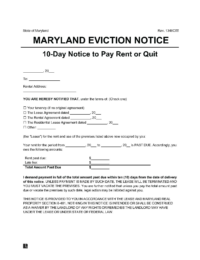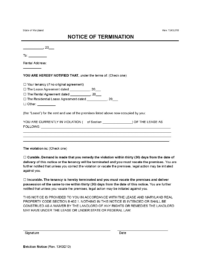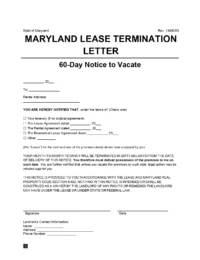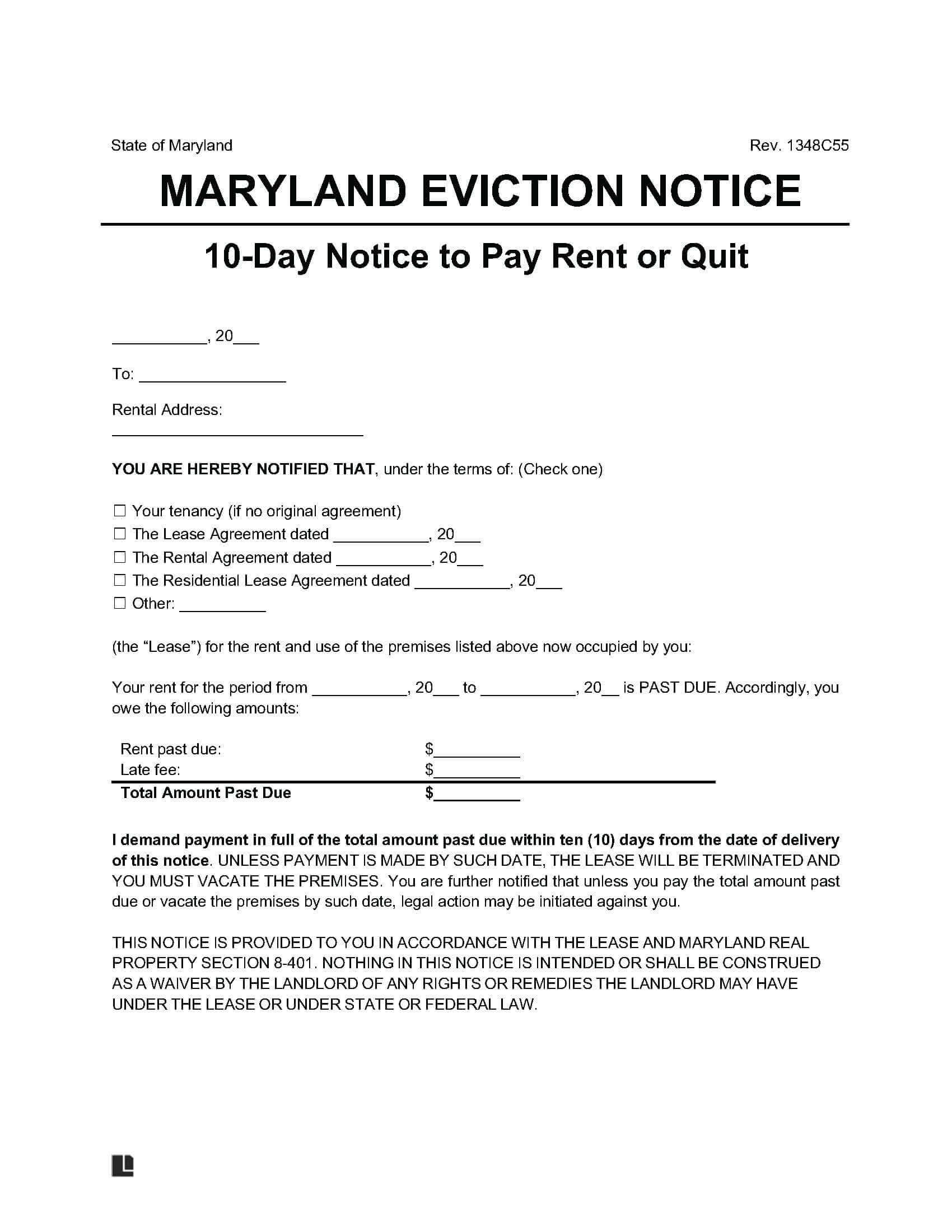Understanding Eviction Notices in Maryland
Landlords in Maryland must serve tenants with a written eviction notice before filing in court. The type of notice depends on the reason for eviction, such as unpaid rent, lease violations, or ending a month-to-month tenancy.
Use our document builder to create a personalized Maryland eviction notice. Just answer a few simple questions, and download your completed form in PDF or Word format.
Types of Eviction Notices in Maryland
Maryland landlords must use the correct notice based on the lease violation or reason for ending the tenancy. Each notice has a required timeline under Maryland law.
10-Day Notice to Quit for Non-Payment
Use this notice if a tenant has failed to pay rent. Under Maryland Real Property Code § 8-401, landlords must give tenants 10 days to pay or vacate before filing for eviction.
10-Day Notice to Quit for Non-Payment
Use this notice for rent non-payment, allowing tenants to pay or vacate, with eviction proceedings possible if unresolved.
30-Day Notice to Quit for Non-Compliance
This notice is used when the tenant violates the lease in a way that does not involve rent, such as unauthorized occupants or other breaches. Tenants have 30 days to comply or vacate under MD Real Prop. Code § 8-402.1(a)(1)(i)2.A.
30-Day Notice to Quit for Non-Compliance
Use this notice for lease breaches, allowing tenants time to comply or face tenancy termination and potential eviction.
60-Day Lease Termination
To end a month-to-month lease without cause, landlords must give tenants 60 days’ written notice under MD Real Prop. Code § 8-402. This applies when you are not renewing the rental agreement.
60 Day Lease Termination
Use this notice to terminate month-to-month rental agreements.
Eviction Laws & Requirements
- Eviction Lawsuit: Maryland Real Property Code §§ 8-401 – 8-402.1.
- Grace Period for Rent Payment: No grace period for non-payment of rent unless stated in the lease agreement (§ 8-401).
- Late or Non-Payment of Rent Notice: 10 days (§ 8-401).
- Non-Compliance with Lease Notice: 30 days (§ 8-402.1(a)(1)(i)2.A).
- Dangerous or Harmful Activity Notice: 14 days (§ 8-402.1(a)(1)(i)2.B).
- Substantial Damage to Property Notice: 14 days (§ 8-402.1(a)(1)(i)2.B).
- Lease Termination (Month-to-Month) notice: 60 days (§ 8-402).
How to Evict a Tenant in Maryland
Evictions in Maryland must follow the process outlined in MD Real Prop. Code §§ 8-401 – 8-402.1. Here’s how it works:
Step 1- Send Eviction Notice
If the tenant violates any lease terms or you want to end a month-to-month tenancy, you or your attorney must first provide the appropriate type of eviction notice. The type of Maryland eviction notice you select depends on the lease violation and the provisions in the original rental agreement.
It should be sent by first-class certified mail, affixed to the property door, or by electronic delivery (if the tenant previously agreed to the electronic method).
Step 2 – File Initial Court Documents for Eviction
If the tenant doesn’t comply with the eviction notice, you can request the required court forms for an eviction action from the appropriate District Court based on the property is location.
The written notice or complaint must include the address of the leased premises, details of the tenancy, and reasons for the eviction, including, if relevant, how much rent is due. Along with the initial court forms, you must also pay a filing fee, depending on the type of eviction and where the property is located.
Step 3 – Serve Tenant
The landlord must give the tenant a copy of the documents he filed in court. The landlord can request that the local county sheriff deliver the Complaint and District Court Summons to the tenant, either in person or through first-class certified mail. The tenant must appear before a judicial officer on a specific court date to respond to the eviction action.
If the eviction is based on non-payment of rent, the tenant can stop the eviction by paying rent in full, along with any late fees and court costs, by the day of the trial. The eviction stops if the tenant pays rent in full before the judge makes a final judgment.
Step 4 – Court Judgement
If the tenant doesn’t appear in court (results in a default judgment for the landlord) or the judge rules in favor of the landlord, the court will enter a judgment for possession. The tenant is allowed four (4) business days to leave the property.
Step 5 – Petition for Warrant
If the tenant fails to vacate the property within four (4) business days, the landlord must file a Petition for Warrant of Restitution, which can only be obtained from the District Court. The landlord provides the signed warrant to the sheriff’s department, which may evict the tenant.
Related Maryland Court Forms
Maryland requires physical copies of court forms to be obtained in person. However, there are a couple of samples available on the Maryland Court website for reference:
- Notice of Intent to File a Complaint for Summary Ejectment (Failure to Pay Rent) (DC-CV-115).
- Sample Complaint, Failure to Pay Rent Form (DC-CV-082): The act of filing a complaint must be completed by the landlord or their lawyer and include the reason/s for eviction. It must be filed with the District Court in the county where the property is located.
- Petition for Warrant of Restitution (DC-CV-081): Once approved by the court, this form lets a landlord have the sheriff remove their tenant if they refuse to vacate the property.
- The eviction must occur within 60 days after the court orders the Warrant of Restitution, and you must file the request for such a Warrant within 60 days of the court’s original judgment. Eviction proceedings cannot take place on a Sunday or holiday.








